Choosing a Dog Breed Based on its Appearance
By Michele Welton, Dog Trainer, Breed Selection Consultant, Author of 15 Dog Books
Fencing needed for confinement
Risk of Aggression Toward People
Risk of Aggression Toward Other Dogs
Build, shape, tail, ears, colors
If you don't yet have a dog, you might have strong opinions on what you want that dog to look like.
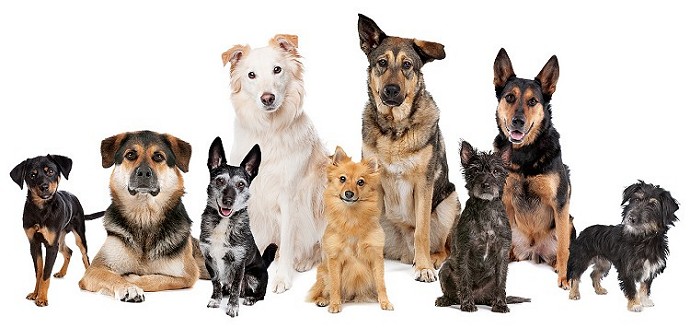
We've already seen that certain physical features should definitely be considered when choosing a breed.
- Size is important because different size dogs require that you provide a different kind of home and yard, space and exercise, and safety.
- Coat is important because you must be able to provide the amount of brushing and trimming required by that coat, and you must be able to handle whatever amount of shedding is produced by that coat. Too many dogs are surrendered to shelters for "getting too matted" or "aggravating my allergies." You don't want to be that kind of owner.
But what about other physical features? In your opinion, what does a "good-looking dog" look like?
Slender or muscular? Long-legged or short-legged? Pricked ears or floppy ears? Colors?
Everyone will answer that question differently because everyone has their own personal preferences.

Benji, a loveable mixed breed who appeared in several movies. Do you like this look?
- You might love rustic-looking dogs with floppy ears, like Benji.
- Your spouse might love muscular dogs with massive heads.
- Your best friend might prefer wolfish dogs with prick ears and a curly tail.
As personal preferences, they're all perfectly valid. But in this article, I want to explain how some preferences come with health consequences that you might not be aware of.
Do you like a slender body and long slender legs?
Joel says, "I like skinny dogs with long legs, like greyhounds. They look sleek and fast!"
What Joel needs to know:
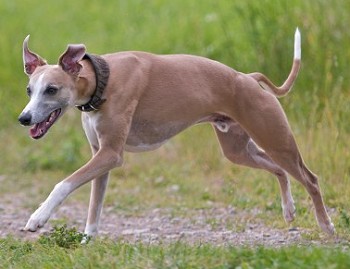
Whippets belong to the sighthound family of dogs.
The family of dogs called sighthounds have slender bodies and long, slender legs. Sighthounds are hunting dogs with strong prey instincts, bred to spot foxes, rabbits, coyotes, even wolves, at long distances, then run those unfortunate animals down with their blazing speed.
Although sighthounds are much stronger than they look, their long slender legs are prone to fractures and their feet to broken toes.
Protect their thin skin from pressure sores by providing thick blankets or a cushy memory-foamish mattress. And let them sleep on your sofa.
With so little fat on their bodies, sighthounds are tricky to medicate or anesthetize without overdosing. I would never take a sighthound to a vet's office without ensuring beforehand that the vet is very experienced with sighthounds. Most vets aren't.
Do you like long droopy ears?
Charity says, "I like dogs with long heavy ears, like Cocker Spaniels and Basset Hounds. It gives them a sad, wistful look!"
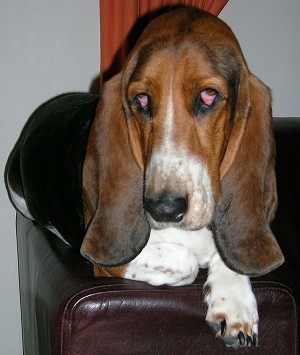
Basset Hounds have long ears that require careful, ongoing cleaning.
What Charity needs to know:
The ears of spaniels, hounds, and poodles are prone to chronic ear infections and mites. Their long, narrow ear canals trap wax, providing a sticky medium in which fungi and mites can grow and feed.
The heavy "leather" on hound ears are also prone to developing blood blisters. What happens is this... when they shake their head, the heavy ear flaps whip around and pound against their own body, or the wall, and blood blisters may form, some requiring veterinary attention.
Do you like loose floppy lips?
Jeanne says, "My boyfriend likes dogs with big lips, like Saint Bernards. But don't they drool a lot?"
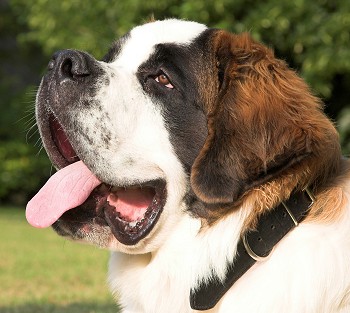
Saint Bernards have loose, floppy skin around their lips. These dogs are champion droolers and slobberers!
Yup! Not only Saint Bernards, but also Newfoundlands, Basset Hounds, Mastiffs, Bernese Mountain Dogs, Bulldogs, etc.
What Jeanne's boyfriend needs to know:
Loose lips tend to slobber and drool. These dogs are very sloppy drinkers. Experienced owners keep paper towels and hand towels in strategic locations around the house!
These dogs are also prone to lip infections. The loose folds of skin trap dirt and moisture for bacteria and yeast to feed on.
Loose skin around the eyes (seen in the same breeds) can cause their lower eyelids to sag, which could require surgery. See the Basset Hound's eyes in the pic just above the Saint Bernard.
Do you like a deep-chested dog?
Bryan says, "As a body builder, I'm impressed by athletic physiques. I admire dogs with a deep chest."
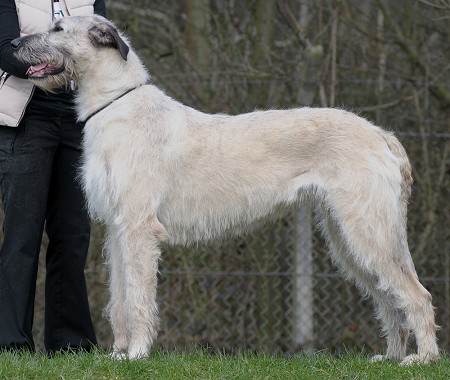
Irish Wolfhounds are one breed with a deep chest extending to (or below) the dog's elbows. Lots of large purebred dogs have a chest like this. It is less common in crossbreeds and much less common in mixed breeds.
What Bryan needs to know:
In medium-sized to giant-sized dogs, a deep chest is closely associated with an emergency gastrointestinal syndrome, informally called bloat . The technical name is gastric torsion or GDV (gastric dilation-volvulus).
Bloat strikes suddenly. One minute the dog is fine, then he's uncomfortable, then in distress. Even with immediate treatment, the fatality rate is about 50%. It is a leading cause of death in many breeds with a deep chest.
Essentially – for no apparent reason – the stomach fills up with food, air, and gas, and keeps expanding, becoming hard and bloated. This is the dilation phase of GDV.
If the dog is immediately rushed to the emergency room, the vet might be able to relieve the pressure in time.
Otherwise, the swollen stomach will likely twist and/or flip over, taking the spleen and pancreas along with it – this is the life-threatening volvulus phase of GDV. Blood flow to the digestive organs is now blocked, resulting in rapid tissue death that cascades into other organs such as the heart. Death occurs quickly.
Even if a vet is able to surgically right the stomach, the threat isn't over, as this condition is likely to re-occur. To prevent it, a minor surgery called gastropexy can suture the stomach to the body wall. It can still bloat, which would still require emergency intervention. But sutured firmly to the body wall, it cannot twist or flip over. This gives the dog a much better chance of surviving another attack.
You might be wondering why bloat primarily attacks breeds with a deep chest? Simply because in a deep chest, there's more "wiggle room" for the stomach to move around and twist. A deep chest is not natural in dogs – it's a creation by breeders. That's why bloat is much less common in mixed breeds.
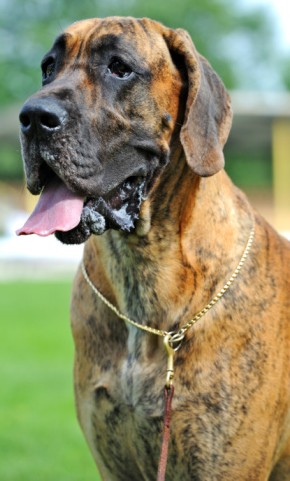
This brindle Great Dane is either the lucky one, or the unlucky one, since roughly one out of every two Danes (45%) will suffer a bloat attack. About half of those will die within just a few hours. It's the #1 killer of this breed.
The most likely breed to bloat is the Great Dane, with about 1 out of every 2 Danes suffering an attack. It is the leading cause of death in this breed.
Just behind the Great Dane in bloat occurrences are the Saint Bernard and Weimaraner.
Other highest-risk breeds (alphabetical order):
- Basset Hound
- Bernese Mountain Dog
- Bloodhound
- Boxer
- Chinese Shar-pei
- Doberman
- German Shepherd
- Golden Retriever
- Gordon Setter
- Great Pyrenees
- Irish Setter
- Irish Wolfhound
- Labrador Retriever
- Newfoundland
- Rottweiler
- Standard Poodle
Other large deep-chested breeds are susceptible to bloat, as well. It can even attack small deep-chested breeds like Dachshunds, but that's much less common.
Do you like short-legged, long-bodied dogs?
 Mary Ann says, "Yes! They look like cartoon dogs with those stubby legs and sausage body!"
Mary Ann says, "Yes! They look like cartoon dogs with those stubby legs and sausage body!"
Examples:
- Basset Hound
- Dachshund
- Pekingese
- Scottish Terrier
- Shih Tzu
- Swedish Vallhund
- Welsh Corgi

About 1 in 4 Dachshunds will become paralyzed due to bad vertebral disks related to their chondrodysplastic build. It's really sad.
What Mary Ann needs to know:
The breeds above have a hereditary deformity called chondrodysplasia. Put simply, the pup inherits incorrect proportions of cartilage and bone, resulting in short, thickened, and sometimes bowed front legs. The pup's longish back may or may not have weak disks that are predisposed to "slipping" and protruding into the spinal canal. This can cause permanent hindquarter paralysis – sadly, this happens to one in every four Dachshunds.
The breeds above are deliberately deformed.
The breeds in the list above have been deliberately created with this deformity because breeders and puppy buyers think it's cute.
Other breeds are accidentally deformed.
Some breeds aren't supposed to be chondrodysplastic, but the genes for the deformity have crept into their gene pools anyway, so SOME pups in these breeds will inherit it.
Most commonly, this deformity pops up in certain lines of Toy and Miniature Poodles and Jack Russell Terriers.
These breeds are supposed to have a square build, where their length from chest to hindquarters should equal their height at the shoulder.
But if they inherit genes for chondrodysplasia, their legs will be short and their backs will be long, and they might (or might not) have weak vertebral disks prone to slipping. Of course they can still make wonderful, loving pets! But spinal problems may plague your pet, and these can be expensive to manage.

The normal, healthy build for a Toy or Miniature Poodle is square (black dog on the left). The silver dog on the right has chondrodysplasia, which may or may not result in chronic back problems.
Do you like short-faced dogs?
Shannon says, "You mean like Pugs? Oh yes! They're adorable, they make these charming faces that look almost human, and hilarious grunting sounds, like a tiny pig!"
What Shannon needs to know:
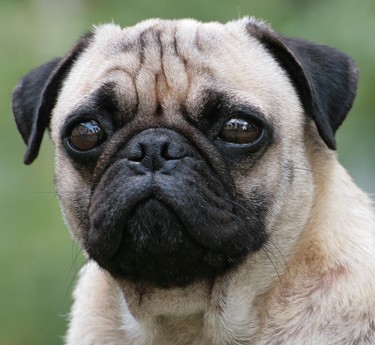
The poor Pug, with his lovely temperament, has been betrayed by breeders who perpetuate these awful physical impairments. Why do people think this is okay to do to a dog?
I've talked about short faces in other articles. But you might not have seen those, and it's important, so I'm repeating it here.
Dogs with a short face (Pugs, Boston Terriers, Boxers, Bulldogs, etc.) have a hereditary deformity called brachycephalic (BRAK-uh-sa-FAL-ic) syndrome.
This isn't something a pup "might" get. ALL of the dogs in these breeds are brachycephalic. Some are more extreme than others, but all of them are born with malformations of their nostrils, windpipe, and soft palate (the flap of skin across the back of the throat that blocks food and water from entering the windpipe).
With all of these abnormalities, it's no wonder that all short-faced dogs have trouble breathing normally. Instead they're forced to snort, snuffle, grunt, snore, gag, hack, and spit up food.
Because their nostrils are so constricted, they may breathe through their mouth... which causes them to swallow air... which produces excessive gas and flatulence.
Short-faced dogs are at high risk for heatstroke. Dogs can only cool themselves by panting vigorously over the sweat glands on their tongue. But short-faced dogs can't push enough air through their constricted windpipe to accomplish that task in hot weather, or when their body heat is too high because they're been exercising. In hot weather, short-faced dogs require an air-conditioned room.
Short-faced dogs are risky to anesthetize. You need to find an experienced vet to do neutering and dental cleaning of these breeds.
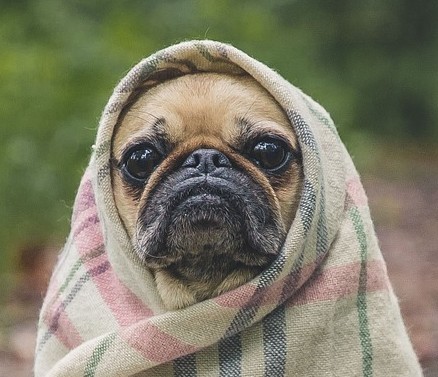
No dog should have to deal with all this.
And it's not just their respiratory system that's deformed.
- Their eye sockets are so shallow that their eyes can actually pop out if the dog pulls too hard on the leash.
- The prominent eyeball is susceptible to scratches and corneal ulcers, and if the eyelid can't reach out far enough to fully cover the protruding eyeball, the eye can dry out.
- In the shortened mouth, the teeth are crowded together and tend to grow at odd angles, trapping food debris and leading to dental disease.
Honestly, it would be wise for breeders and owners of brachycephalic breeds to heed the old saying: "It's not nice to fool Mother Nature."
Do you like dogs with a very short tail?
Lydia says, "Yes, I call them wiggle-butts because it looks like he's wagging his whole bum!"
What Lydia needs to know:
Sometimes a dog will be born with a natural bobtail, but the vast majority of "wiggle-butts" have had their tail docked. Dock means to cut short. A docked tail starts out like a regular long tail, but is cut short when the puppy is a few days old.
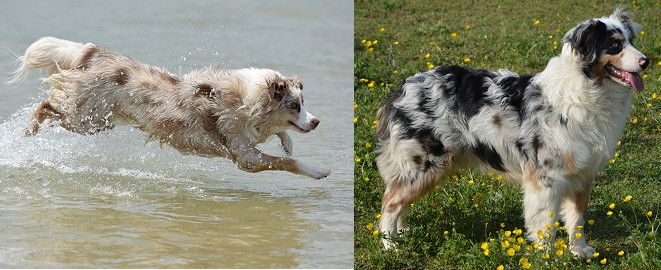
Australian Shepherd on the left has his natural tail. Aussie on the right has been docked.
In some breeds, only the tip of the tail is cut off. But in most breeds, more than half the tail is removed. A few breeds are docked down to little more than a stump.
Which breeds are supposed to be docked? Well, fans of docking will tell you:
- that hunting dogs (pointers, spaniels, terriers) should be docked.
- that guardian dogs (Dobermans, Boxers, Rottweilers) should be docked.
- that herding dogs (Australian Shepherds, Old English Sheepdogs, Bouviers) should be docked.
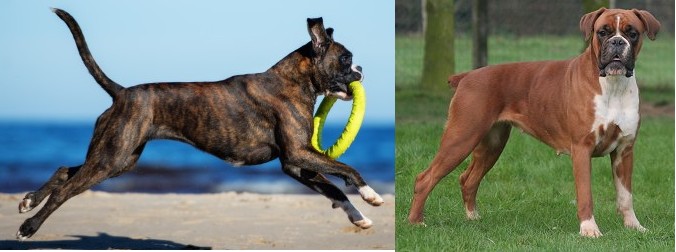
Boxer on the left has her natural tail. Boxer on the right has been docked.
Fans of docking say it prevents tail injuries that might occur if a long tail should accidentally thwack! against something while the dog is working.
It sounds... kind of reasonable, right? And yet...
- Plenty of NON-docked breeds hunt just fine, like English Pointers, English Setters, and even Dachshunds!
- Plenty of NON-docked breeds protect just fine, like Belgian Malinois, German Shepherds, and American Bulldogs.
- Plenty of NON-docked breeds herd just fine, like Border Collies, Australian Kelpies, Bearded Collies, and Shelties. And what about Welsh Corgis? There are two Welsh Corgi breeds. The Pembroke is docked, but the Cardigan isn't. Yet both breeds herd just fine.

Brittany Spaniel on the left has his natural tail. Brittany on the right has been docked.
Plus...
Most dogs today are not used for hunting, herding, or guarding. 99% of the people reading this are looking for a companion dog. So why should their Rottweiler or Cocker Spaniel still have his tail docked?
And what about docked TOY breeds, like Toy Poodles, Yorkies, and Minature Pinschers (Min Pins)? They're not used for hunting, guarding, or herding – so why do they need to be docked?
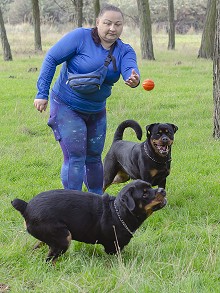
Pair of Rottweilers with natural tail and docked
The truth about docking
The reality is that docking tails is not done for functional reasons, but for aesthetic reasons. Our eye has become accustomed to the shape of certain breeds with a short tail. Thus, Rottweilers look "wrong" with a long tail because we're used to seeing them with a short tail. But Great Danes look "right" with a long tail because we're used to seeing them like that.
The solution is simply to retrain the eye so that the tails of all dogs can be left alone.
Other western countries are way ahead of the US in this regard. Across most of Europe, Australia, and New Zealand, docking has been declared unnecessary and inhumane, and docking has been banned (or heavily restricted).
Docking will eventually become illegal in the United States, as well. But for now, if you choose a breed that traditionally has its tail docked and you don't want it done to your puppy, you'll have to work it out with the breeder before the litter is born. Unfortunately that can be difficult, because the procedure is done only a few days after birth.

The docked pinscher is hampered in his attempts to communicate his intentions. The husky isn't sure what to make of him.
Why do dogs even have tails?
To communicate. High tail, low tail, stiff tail, quivering tail, wagging tail, tail between legs... the tail position of a dog says important things to another dog.
Removing half his tail impairs a dog's abillity to communicate his mood and intentions to other dogs. Friendly? dominant? submissive? Misunderstandings increase the risk of fights.
Also, we humans are accustomed to judging a dog's mood and intentions by the position and action of its tail. It's easier for the average person to evaluate a long tail than a docked tail. Removing half his tail makes a dog vulnerable to being misinterpreted by his owner and the public.
Do you like dogs with ears that stand upright?
Chuck says, "Yeah, I think erect ears look smarter and more alert, compared to floppy ears."
What Chuck needs to know:
There are two types of upright ears:
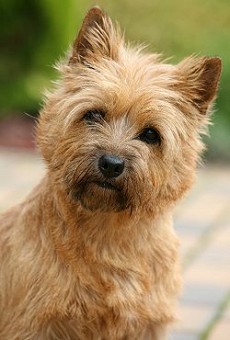
Cairn Terriers have natural pricked ears.
Natural pricked ears. Think of German Shepherds, Belgian Shepherds, Welsh Corgis, Australian Cattle Dogs, Chihuahuas, Papillons, Yorkies, several terriers (Cairn, Westie, Scottie...), and all of the spitz breeds like Siberian Huskies, Alaskan Malamutes, Shibas, etc.
Natural pricked ears start out stuck to the newborn pup's head, or even hanging down like floppy ears. But in a few days, weeks, or months, the ears begin pricking up on their own. (However, sometimes pricked ears only go up partway, or one ear pricks up while the other doesn't. That's due to weakish cartilage in that ear.)

This Doberman's ears have been cropped to stand upright instead of hanging naturally.
Cropped ears. These ears start out hanging and would remain that way except that at 6-12 weeks, a veterinarian anesthetizes the puppy (always a bit of a risk) and cuts his ears into a sharp pointy shape, then bandages them in an upright position to "train" the cut ears to stand erect.
That isn't the end, either. The multiple-week recovery period is very uncomfortable as the puppy endures soreness, repeated bandaging and unbandaging, and itchy tape pulling at his skin. Often the owner isn't satisfied with the length or position of the cropped ears, so a second surgery is done. Or, after months of persistent taping... the ears never do stand up straight. All that risk and pain for nothing.
Which breeds have cropped ears?
| Affenpinscher | Cane Corso |
| American Bulldog | Doberman |
| American Pit Bull Terrier | Dogo Argentino |
| Am. Staffordshire Terrier | German Pinscher |
| Beauceron | Giant Schnauzer |
| Boston Terrier | Great Dane |
| Bouvier des Flandres | Manchester Terrier (Standard) |
| Boxer | Miniature Schnauzer |
| Briard | Neapolitan Mastiff |
| Brussels Griffon | Standard Schnauzer |
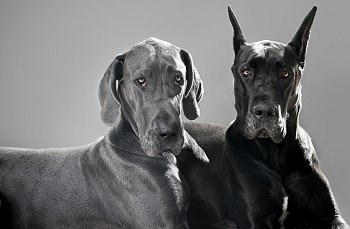
Great Danes with natural and cropped ears.
Fans of ear cropping tell us that cropping prevents ear infections by exposing more of the ear to light and air circulation.
That sounds reasonable... except there's no good evidence for it. Breeders who own both cropped and uncropped individuals of these breeds report no difference in the frequency of ear infections.
The truth about cropping
As with tail docking, ear cropping is done for appearance. Cropped ears give the dog a more alert (and more intimidating, even fierce) expression, and our eye has become accustomed to that appearance.
But are we really that shallow? Can we not retrain our eye so that puppies don't need to suffer this surgery simply so we will like how they look?
Fortunately on this issue, worldwide opinion is marching firmly in the right direction. Cropping is now illegal across most of Europe, Australia, and New Zealand.
In fact, North America is the only significant region in the world where ear cropping is still virtually unrestricted. This is due to the influence of the American Kennel Club and breeders who show their dogs at AKC events. But more and more veterinarians are refusing to do it, describing it accurately as "mutilation" for no good reason.
Cropping will eventually be banned in the United States. But for now, if you choose a breed that traditionally has its ears cropped and you don't want it done to your puppy, you should arrange for that with the breeder before the cropping age of 6-12 weeks (different times for different breeds).
COAT COLOR
Dogs comes in a vast array of colors and markings, and for the most part, the color you choose is simply personal preference.
But there are some things that you might not know about certain canine colors, that might make you change your mind about getting that color. Let's see.
"RARE" COLORS
Dog buyers often find themselves drawn to a breeder's marketing shtick of "Rare colors!"
But "rare" can mean different things:
- Rare can mean a color that's discouraged by the breed's national club, and thus breeders who focus on dog shows won't breed for that color. For example, in Labrador Retrievers, silver and champagne (which are diluted shades of the normal chocolate and yellow) are frowned upon by the breed's national club. So they're not commonly seen, and breeders who do produce them usually do it for the money. So expect inflated prices.
- Rare can mean a color that's associated with health problems. For example, white is linked to deafness in white Boxers. Thus, responsible breeders won't deliberately breed for that color.
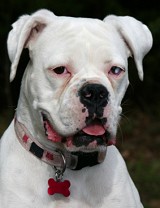
White Boxer
- Rare can mean a color that wasn't present in the breed's normal gene pool. So breeders outcross to a completely different breed that DOES have that color. Then they jack up the prices and wait for buyers who don't know or care that the blue merle Chihuahua they just paid two thousand dollars for may not even be purebred.
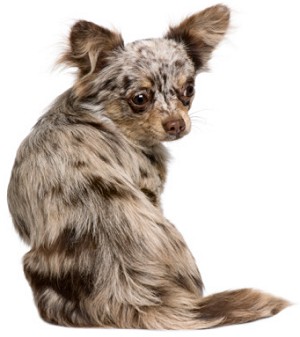
Blue merle Chihuahua... purebred? or not?
Here's the problem I have with breeders who advertise "rare" colors:
Above all else – certainly way above their color – family pets should have a stable, good-natured temperament. They should be structurally sound so they can move and breathe comfortably. And they should be genetically healthy so they can live a long, happy life.
If you want that kind of dog, you should look for a breeder who focuses on those goals as his TOP priorities.
Breeders who focus on superficial traits such as color frequently let the much more important features of temperament and health fall by the wayside. Indeed, they will breed (and often inbreed) any dog who can produce the color the breeder wants, no matter what the temperament or health of that dog is.
So be careful with so-called "rare" colors.
BLACK
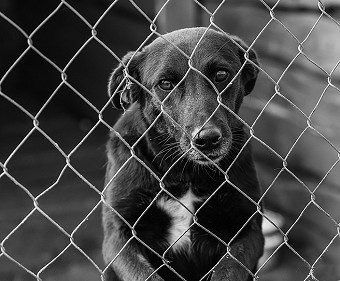
Black dog waits hopefully for someone to think he's beautiful.
Have you ever heard of black dog syndrome? Animal shelter and rescue workers say that black dogs are more likely to languish in shelters as prospective owners bypass their cages to go look at white, cream, golden, or reddish colors first.
Maybe it's superstition along the lines of "black cats bring bad luck" or "bad guys wear black." Or maybe a black coat doesn't look as cuddly? Harder to see at night?
Or... owners love to look into their dog's face, and it can be harder to see the facial expression of a black dog.
Whatever it is, if you're thinking of adopting a dog from a shelter or rescue, please consider choosing a black one. You might be that dog's only hope...
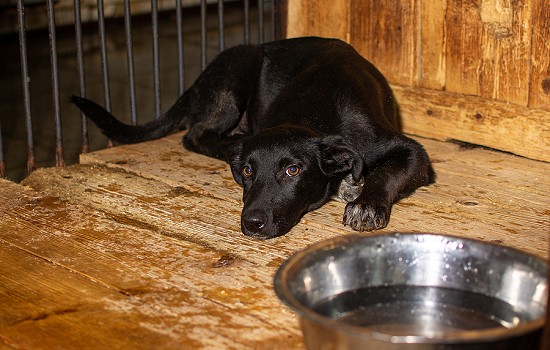
It must be hard to be passed by over and over. This dog seems to have given up hope.
I don't recommend black coats in hot climates, for obvious reasons. Especially combined with a long thick coat... it's dismaying to see black Newfoundlands or Bernese Mountain Dogs struggling to stay comfortable in hot sunny Florida or Texas.
 BLACK AND TAN
BLACK AND TAN
Like black dogs, black and tan dogs also tend to be disregarded by prospective owners.
However, if someone wants a dog to look intimidating to bad guys, he might choose a black and tan dog on purpose because it's the same color pattern as Dobermans, Rottweilers, and German Shepherds.
BROWN
Many breeds come in some shade of brown, though it might be called chocolate (Labrador Retriever), liver (Irish Water Spaniel), red (Doberman), sedge (Chesapeake Bay Retriever), and other creative color names.
As a prospective owner, be aware that most brown dogs have a brown nose and lightish-colored (usually yellowish) eyes that can have an odd staring effect that some people find a little off-putting. If you're fine with it, great!
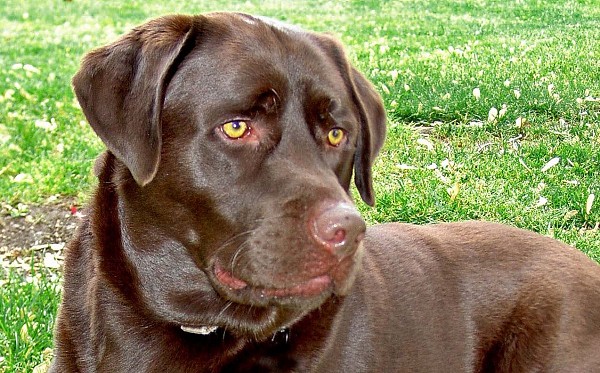
Chocolate Labrador Retriever
Also wanted to mention a study done by an Australian university showing that in Labs, at least, chocolate is linked to a greater likelihood of skin conditions and a shorter lifespan. It is unknown whether this is true of brown dogs in other breeds.
Finally, in my own personal experience with Labs and Poodles, I've found a lot of chocolate individuals to be more impulsive/clownish/energetic compared to other Lab and Poodle colors.
BRINDLE
Brindle isn't actually a color, but a distinctive marking best described as tiger stripes.
Essentially a brindle dog has a lighter base color (from light fawn to deep red) with darker (usually black) stripes on top.
Brindle marking might cover the entire coat, or only some parts of the coat. My own Chihuahua has brindle markings on her muzzle and legs.

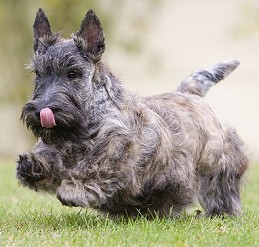
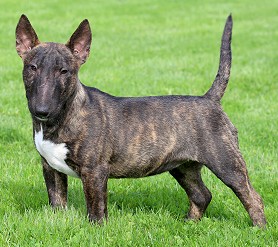

Clockwise: Bullmastiff, Scottish Terrier, Whippet, Bull Terrier
Common breeds that may have brindle markings:
| Akita | English Bulldog |
| American Pit Bull Terrier | French Bulldog |
| Am. Staffordshire Terrier | Great Dane |
| Basenji | Greyhound |
| Boston Terrier | Irish Wolfhound |
| Boxer | Italian Greyhound |
| Bullmastiff | Old English Mastiff |
| Bull Terrier | Pekingese |
| Cairn Terrier | Scottish Terrier |
| Cane Corso | Staffordshire Bull Terrier |
| Chihuahua | Whippet |

Dark blue Chihuahua. The color blue ranges from light silver to gunmetal blue to dark charcoal. This is my rescue Chihuahua, Mouse.
BLUE/GRAY
Some breeds come in a gray color that is officially called blue because... well, because it sort of looks bluish. In the right light. I guess.
Unlike black or brown, blue is not a normal color in dogs. There isn't a blue gene. Instead, a blue dog has inherited a normal black gene, plus a dilution gene that washes the black into a grayish shade that dog fanciers optimistically call blue.
Unfortunately, there is a skin condition associated with dilution genes. The symptoms are a gradual thinning or complete loss of the blue hair, plus (sometimes) nodules on the skin that can result in chronic bacterial infections. It's a lifelong condition, but manageable with a homemade diet and supplements, and special baths.
Does every blue dog have this disease? No.

Silvery blue Doberman
- Some breeds are more affected than others. It's by far most common in Dobermans, with 60-80% of blues affected. But it also appears in Chihuahuas, Italian Greyhounds, Min Pins, Dachshunds, Great Danes, Whippets, Poodles, Chows, and others. It can even appear in blue mixed breeds.
- Some shades of blue are more affected than others. Lighter (silvery) blues are the most common victims, while darker (steel blue) blues are less likely or less severe.
- Pay attention to the parents. If neither of the pup's parents is blue, or if only one parent is blue (and has a healthy coat), a blue puppy is less likely to have inherited the disease. If both parents are blue... well, responsible breeders would not breed blue-to-blue because of the higher risk of pups being affected.
MERLE
Merle isn't a color, but a pattern, namely a swirled/mottled/dappled blend of darker colors on a white background. Blue merle and red merle are most common. Eyes may be brown, blue, or one of each.
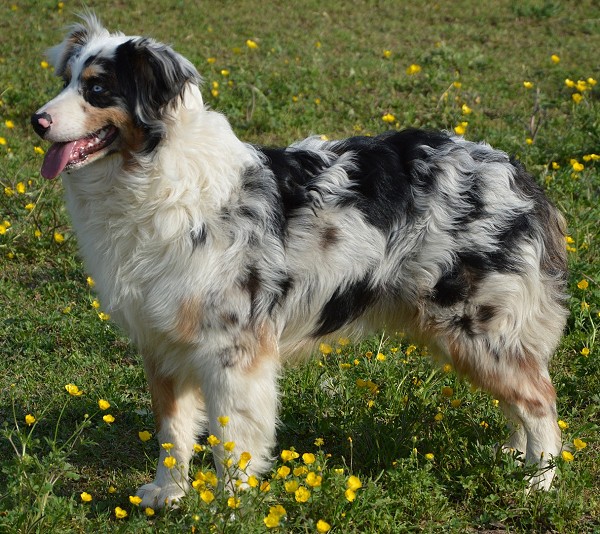
Australian Shepherd, blue merle
Common breeds that come in the merle pattern:
| Australian Cattle Dog | Dachshund |
| Australian Shepherd | Great Dane |
| Beauceron | Old English Sheepdog |
| Border Collie | Rough/Smooth Collie |
| Cardigan Welsh Corgi | Sheltie |
| Catahoula Leopard Dog |
So what's the problem with merle?

Cardigan Welsh Corgi, blue merle
You might remember when we talked about the color Blue/Gray (see section above) where I said that dilution genes act on dark pigment by washing it into a paler color.
Much like that, merle genes act on dark pigment by whitening it randomly. This produces the lovely swirls and patches.
Unfortunately, that random whitening effect is not limited to body hair. There are also tiny hairs, called cilia, deep inside a dog's ears. These are essential for hearing, and they must be pigmented (any dark color) in order for the nerve endings to conduct auditory impulses (sound). If the merle gene causes this pigment to whiten too much, the nerve endings atrophy, resulting in total or partial hearing loss.
In merle dogs, this is most likely to happen if the pup has inherited a merle gene from EACH parent. We call these pups double-merles. Educated breeders will never breed merle to merle – sadly, most breeders are not educated and so they do just this.
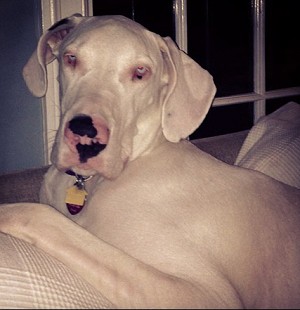
Deaf Great Dane. Photo by dougcornelius, licensed with CC BY 2.0
It's usually easy to spot a double-merle dog in a breed that comes in merle. He will be completely white, or mostly white with limited merle markings. Sometimes only one side of his head is colored. Typically his nose is pink, or mostly pink. Often the skin around his eyes is pink, and typically the eyes are abnormally small and bluish. In double-merle dogs, not only their hearing but also their vision is usually affected, and they are highly vulnerable to sunburn and skin cancer.
PIEBALD
Piebald means patched – a dark coat with irregular white patches.
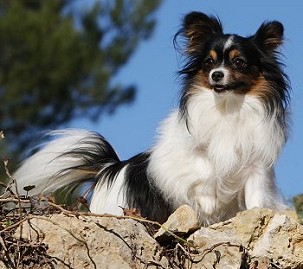

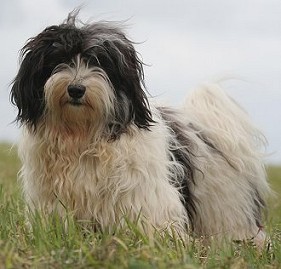
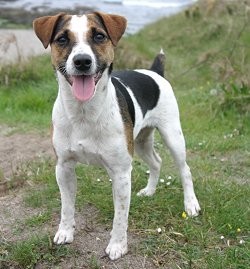
Clockwise: Papillon, French Bulldog, Jack Russell Terrier, Havanese
This color is usually fine; however, like the merle gene, the piebald gene can cause congenital deafness if a pup inherits it from EACH parent.
Like double-merles, double-piebalds are mostly white with only a few dark markings on their head, back, or base of the tail. Usually their eyes are blue, but not always.
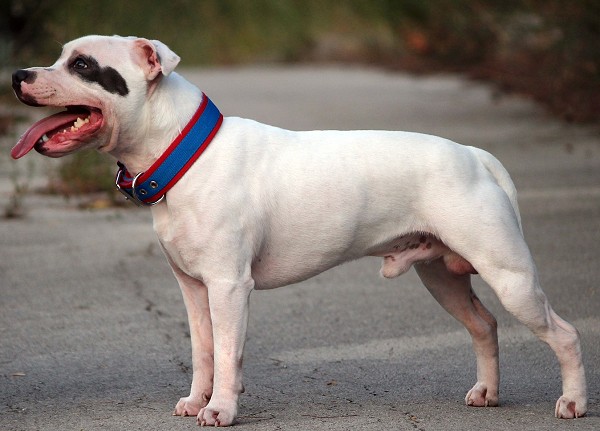
Staffordshire Bull Terrier
- If a double-piebald dog has inherited enough colored pigment around his eyes and the base of his ears, there should be no health issues other than sun sensitivity.
- But if pigment is very minimal (see Pit Bull pic below), skin cancer is a real risk, along with deafness. Partial deafness (one ear) doesn't bother a dog, as the other ear can compensate. But complete deafness (both ears) can be very challenging to raise and train.

Deaf Pit Bull. Double-piebald can be associated with insufficient pigment in the ear, resulting in deafness.
In the following breeds, you should confirm the hearing status of individuals who are mostly white with only a few colored spots/patches on their head, back, or base of the tail:
| American Bulldog | English Bulldog |
| American Pit Bull Terrier | English Setter |
| Border Collie | French Bulldog |
| Boston Terrier | Great Pyrenees |
| Boxer (White) | Havanese |
| Bull Terrier (White) | Jack Russell Terrier |
| Cavalier KC Spaniel | Papillon |
| Cocker Spaniel | Staffordshire Bull Terrier |
| Dalmatian | Welsh Corgi |
| Dogo Argentino | Whippet |
NORMAL WHITE
Don't be worried that every white pup you see is likely to be deaf! Most white dogs DO have pigmented cilia inside their ears, just as they have a pigmented (black or brown) nose, pigmented lips, and pigmented paw pads. Thus, most white dogs hear fine.
But there's one more thing to mention about white dogs... when they run and play, their coats end up looking a bit grungy! How will you feel about that?

West Highland White Terrier, doing what they do best – digging in the dirt and romping in the mud!
When you're thinking about colors, you need to feel comfortable letting your dog run and play, knowing that he's going to need yet another bath...
So if you're a neat freak who must always have things super-clean, a white dog might not be a good choice!
My best-selling books – now available FREE on my website
 Respect Training For Puppies: 30 seconds to a calm, polite, well-behaved puppy is for puppies 2 to 18 months old. Your puppy will learn the 21 skills that all family dogs need to know. Click here to read for free.
Respect Training For Puppies: 30 seconds to a calm, polite, well-behaved puppy is for puppies 2 to 18 months old. Your puppy will learn the 21 skills that all family dogs need to know. Click here to read for free. Teach Your Dog 100 English Words is a unique Vocabulary and Respect Training Program that will teach your adult dog to listen to you and do what you say. Click here to read for free.
Teach Your Dog 100 English Words is a unique Vocabulary and Respect Training Program that will teach your adult dog to listen to you and do what you say. Click here to read for free. 11 Things You Must Do Right To Keep Your Dog Healthy and Happy helps your dog live a longer, healthier life. Get my honest advice about all 11 Things before you bring home your new puppy, because some mistakes with early health care cannot be undone. Click here to read for free.
11 Things You Must Do Right To Keep Your Dog Healthy and Happy helps your dog live a longer, healthier life. Get my honest advice about all 11 Things before you bring home your new puppy, because some mistakes with early health care cannot be undone. Click here to read for free.
